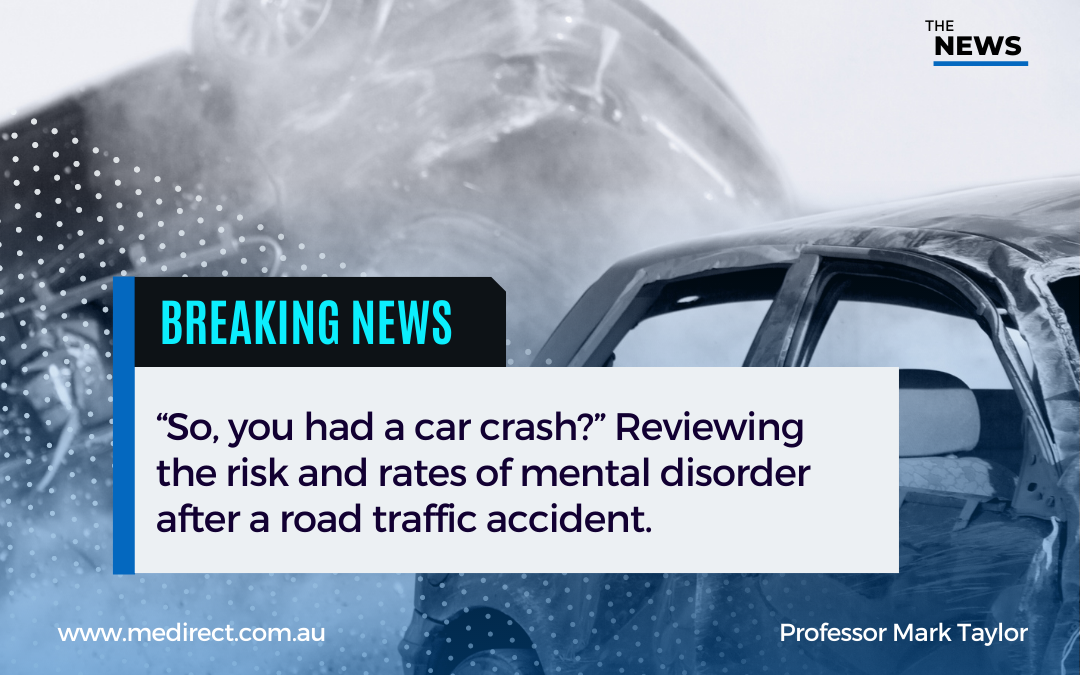Car Crash – Mindcafe
“So, you had a car crash?” Reviewing the risk and rates of mental disorder after a road
traffic accident.
Introduction
Road traffic or motor vehicle accidents are common in Australia and elsewhere. Over 50
million people have a road traffic accident (RTA) in a year, and RTAs are now the third single
most common cause of death worldwide (WHO, 2020). For example, the Australian Roads
Death Database reveals the death rate due to RTAs is increasing and now stands at 4.4 per
100K population or 1138 total deaths in Australia for the year ending March 2022. These
figures include passengers, pedestrians, and cyclists involved in RTAs but numerically the
single largest group are drivers.
The financial cost of RTAs to the Australian economy has been estimated as $17b pa or 2.3%
of the GDP.
Whilst reliable data collection can be problematic, other countries are no better if not worse
than Australia, with surveys showing Spain’s death rate is 33% of all crashes; USA being
28%; Japan 9% and France at 8%. Certainly, a public health issue.
Additionally, there is significant non-fatal morbidity associated with RTAs as anyone who
has worked in trauma knows. Given my recent clinical experiences of assessing victims of
RTAs, I decided to review the available data on rates and risks of mental disorder or illness
after an RTA. I excluded head injury and acquired brain injury as initial searches revealed
that would merit an entire paper on its own!
Post-traumatic stress disorder
Post-traumatic stress disorder (PTSD) according to both DSM 4 and DSM 5 diagnostic criteria
consists of:
- a serious threat to life or of injury;
- re-experiencing the event via dreams or ‘flashback’ memories;
- dysregulated mood
- over-arousal;
- avoidance behaviours
- and all these above being present for more than one month after the accident.
ICD 11 (published last year) has moved much closer to the DSM definitions in its diagnostic
criteria, compared to the earlier broader ICD 10 guidance.
In a systematic review from 2013, Heron-Delaney et al found that PTSD rates varied globally
(in the 35 studies included) between 6 and 45% after an RTA. The strongest consistent
predictors of PTSD post-RTA were noted to be continuing ruminations about the trauma; a
perceived threat to life; a lack of social support; the severity of the initial acute stress
disorder; ongoing physical problems and co-existent anxiety and depression; and
interestingly, ongoing involvement in litigation.
A meta-analysis from Lin and colleagues (2018) revealed a pooled prevalence estimate for
PTSD of 22% among RTA survivors, with female gender; black ethnicity; and a lower
educational level predicting the development of PTSD in studies from Australia; Israel, the
UK and the USA.
Kenardy et al, in a telephonic follow up of 336 RTA survivors from Queensland over 2 years,
found quality of life over that period was adversely affected by a diagnosis of PTSD,
although there was a caveat that these subjects were seeking compensation.
Lastly, a recent (Boelen et al, 2022) study of 328 young adult (66% female) victims of RTA
from the Netherlands was faintly reassuring, with the authors finding that most people
responded resiliently to a non-fatal RTA, with only (my italics) one third of the group
developing moderate to severe trauma symptoms. Severity of the PTSD symptoms here was
linked to the degree of associated grief, suggesting a focus for therapy, with trauma or
accident rumination also being a key predictor of PTSD severity and thus another important
treatment target.
It is worth bearing in mind that PTSD is often slow to recover, with just under half of all
cases still being symptomatic three years after the index trauma.
Depression and anxiety
There is a lot of comorbidity and overlap between depression, anxiety, and PTSD in clinical
populations post-RTA, and both mood and anxiety related symptoms are part of the main
diagnostic criteria in PTSD. Rarely, major depressive disorder can develop after an RTA
without PTSD but a review (Almutairi et al, 2019) found that 82% of cases with depression
also had PTSD.
The same review noted various forms of anxiety are commonly seen in victims after an RTA,
with travel phobia developing in around 31% and generalised anxiety in 55% of those
admitted to hospital post-RTA. Common anxiety symptoms reported included feeling faint
and dizzy, and having wobbly legs.
Adjustment disorder
Apparently, adjustment disorders are the single most widely diagnosed mental health
condition by psychologists but are also the most poorly researched. Here again, the new
ICD11 diagnostic definition is converging with DSM with criteria for diagnosing an
adjustment disorder being:
- disproportionate distress and
- significant impairment
- within 3 months of the index event,
- Recovery must occur within 9 months, post-stressor
- in ICD11 a preoccupation with the stressor and a failure to adapt.
So, it is by definition a benign prognosis condition. The same research group in NSW, from a
prospective study in BMC Psychiatry in 2018, found that where there was a major
depression in the aftermath of an RTA, then ‘many’ also met criteria for an adjustment
disorder. They also noted that prolonged litigation prolonged the physical and psychological
disability.
Outcomes of an RTA
A prospective study from New South Wales (Gopinath et al, 2020) showed better outcomes
12 months post-RTA, perhaps unsurprisingly, in those reporting less pain and less
psychological distress, as well as those not claiming compensation.
Prolonged work absences, due to either physical or psychological injury or both, after an
RTA have a negative impact on the victims’ financial status and even promotion prospects.
Cohort studies summarised by Almutairi and Altamimi (2019) documented that 25-37% of
RTA victims reported a delay or a problem in returning to work.
The NSW study cited above though indicated that it wasn’t the severity of any RTA physical
injury that predicted a delay in return to work, but rather any pre-existing long-term
medical problems or new mental health issues such as PTSD, depression or anxiety which
were more prognostically relevant. Of the RTA associated psychological problems, Kenardy
et al found that people with PTSD had the worst outcome or prognosis.
Another important clinical area not highlighted here in the studies is the development of
chronic unexplained pain, which can enter a vicious cycle with depression. Chronic pain
syndromes are often complex biopsychosocial problems, which can be perpetuated by
ongoing litigation. A holistic view of chronic pain, akin to functional neurological disorder, is
required in its formulation and management, with the individual’s biographical and clinical
history seeming just as important as the nature and severity of the index RTA injury.
Conclusions
There is no such thing as a good road traffic accident. RTAs are now so common that
everyone has had one or knows someone who has had one.
Speed limits; seatbelt wearing; and drink and drug testing all help but are offset by the
increasing numbers of cars and drivers, and the ubiquitous addiction to mobile phones.
PTSD and then specific travel anxiety (phobic anxiety) are the most common adverse
psychological sequelae of RTAs, with approximately one third of those people involved in
RTAs going on to develop PTSD and / or travel anxiety.
Thankfully effective evidence-based treatments exist for these disorders, and in Australia
the access to specialist treatments such as trauma therapy and EMDR, never mind
judiciously used psychotropic medication, is better than in many other places.
Risk factors for PTSD after an RTA include the perceived index threat severity; ruminating
over the trauma; pre-existing mental health problems; ongoing physical problems; ongoing
litigation; and female gender.
There also appears to be a persuasive argument for both early intervention in high-risk
cases post RTA, and a requirement for speedy resolution of any associated litigation.
Drive carefully folks!
Professor Mark Taylor, BSc (Hons); MBBS; MD; FRCPsych; FRCP; FRANZCP
References
Almutairi NM, Altamimi MA. The psychosocial consequences of road traffic accidents: a review article. IJMDC. (2019) 3(12): 1104-1109
Boelen PA, Eisma MC, de Keijser J, Lenferink LIM (2022) Traumatic stress, depression, and non-bereavement grief following non-fatal traffic accidents: Symptom patterns and correlates. PLoS ONE 17(2): e0264497.
Gopinarth B, Jagnoor J, Kifley A et al (2020) Predictors of health-related quality of life after non-catastrophic injury sustained in a road traffic crash. Annals of Physical and Rehabilitative Medicine. 63:4, 280-7.
Heron-Delaney M, Kenardy J, Charlton E, Matsuoka Y. (2013) A systematic review of predictors of
posttraumatic stress disorder (PTSD) for adult road traffic crash survivors. Injury. 44(11):1413–22.
pmid:23916902
Kenardy J, Heron-Delaney M, Hendrikz J et al. (2017) Recovery trajectories for long term quality of life
following road traffic crash injury. Results from the UQ Support study. J Affective Disorders. 214, 8-14.
Lin W, Gong L, Xia M and Dai W. (2018) Prevalence of post-traumatic stress disorder among road traffic
accident survivors. Medicine. 97:3,




